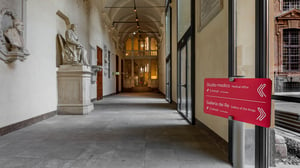We live in spaces, but spaces also live within us, in a principle of circularity. Natural and man-made space and the meaning we attach to places help everyone’s perception of well-being.
Designing everyday spaces, with social infrastructures in sensitive settings like schools and hospitals, is important to how we experience the space, in reducing anxiety and in increasing the potential for every individual to respond positively.
“The pandemic put every person, organisation and system to the test. First and foremost the health system, including general practice. Stress, symptoms like insomnia, the difficulty of balancing work and family life, and burnout have increased," says Guido Giustetto, President of the Order of Surgeons and Dentists of Turin.
This is the basis for a unique project developed by the Turin Architecture Foundation: designing medical clinics in beautiful and important spaces like museums and libraries. It is an ambitious project that aims to redesign services by reducing stress, giving value to waiting time, and introducing a wide and varied public to arts institutions that already have 'intense architecture', i.e. already capable of transmitting emotions.
Doctors in arts spaces
The “Cultura di Base” experiment will start in Turin in May. Five GP surgeries that are part of the City of Turin Local Health Authority, chosen after a public call for tenders, will move to five arts spaces of different types, era and urban area of influence, both in the city centre and the outskirts, in modern and historic buildings.
In the pilot phase these new doctors' surgeries have taken up residence in museums: the Egyptian Museum, MAUTO (the Automobile Museum), the PAV Park of Living Art, the Primo Levi Civic Library and the Polo del '900, which will become waiting and visiting rooms for GPs and involve the patients in a completely new experience.
“It may seem wishful thinking at this difficult moment in time (...) but right now it is vital to rethink services and strengthen the care relationship between doctor and patient, by revolutionising the space in which it takes place,” adds Giustetto.
Currently a GP in Italy, chosen by individual citizens, works at an outpatient clinic, often located in a residential apartment that has been adapted and was not initially designed for the purpose. People of all ages and backgrounds visit this space. They have a wide range of conditions and actionable responses, from primary and secondary prevention to acute and chronic conditions.
Architecture as a kinaesthetic experience
Cultura di Base designs GP surgeries with the skills of user experience designers using participatory design processes to develop a format based on real needs and expectations as part of behavioural, interpretative and emotional models of reference that already exist in the experience of patients and doctors. Architecture is imagined as a kinaesthetic and multi-sensory experience, for healthcare professionals and citizens and becomes part of the care path itself, aimed at reducing prejudices and alleviating concerns.
Doctors and patients will be guided and have the support of a combination of communication, flow and space interpretation and display solutions.
Cultura di Base has involved a network of partners, including the Order of Doctors and Dentists of Turin and the Circolo del Design to create the potential to expand and become a permanent part of the system.
Over 50 arts venues with the right features (architectural quality, emotional potential, accessibility, availability of space and staff, and absence of architectural barriers, etc.) have already been identified. These include spaces that effectively produce and promote the arts, schools and universities, galleries, places of memory, libraries and new cultural centres.
The effects on the doctor-patient relationship
The trial will last around 6 months (May to October 2022) and is accompanied by a counterfactual impact assessment, with population-based control samples. It will include qualitative surveys of staff, patients and teams using questionnaires and participatory observations with ethnographic methods, to publicly report on the effects of the experience (both as a whole and in terms of individual initiatives) on the doctor-patient relationship, the working partnership, wellbeing at work and the health goals achieved.
“We’ve wanted to humanise care spaces like hospitals for a long time now, but we expect to see a clear reduction in the stress of waiting in uncomfortable places and an increase in the psycho-physical well-being of caregivers and patients from this experience in arts spaces. All relationships, including within the team itself, will benefit,” says Eleonora Gerbotto, head of the Architecture Foundation.
The project is supported by and is part of Well Impact, a multi-year strategic plan launched three years ago by the Compagnia di S. Paolo Foundation, one of Europe's largest philanthropic associations, to promote a virtuous relationship between the Arts and Health. There are four flagship projects centred on the same number of themes, including the humanisation of care and related spaces.
By Catterina Seia and Sara Uboldi
Sara Uboldi Dottore di Ricerca in Scienze Umanistiche, Università di Modena e Reggio Emilia

